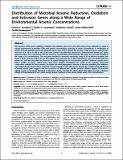Por favor, use este identificador para citar o enlazar a este item:
http://hdl.handle.net/10261/86575COMPARTIR / EXPORTAR:
 SHARE SHARE
 CORE
BASE CORE
BASE
|
|
| Visualizar otros formatos: MARC | Dublin Core | RDF | ORE | MODS | METS | DIDL | DATACITE | |

| Título: | Distribution of Microbial Arsenic Reduction, Oxidation and Extrusion Genes along a Wide Range of Environmental Arsenic Concentrations |
Autor: | Escudero, Lorena CSIC; Casamayor, Emilio O. CSIC ORCID ; Chong, Guillermo; Pedrós-Alió, Carlos CSIC ORCID; Demergasso, Cecilia S. | Fecha de publicación: | 31-oct-2013 | Editor: | Public Library of Science | Citación: | PLoS ONE 8(10): e78890 (2013) | Resumen: | The presence of the arsenic oxidation, reduction, and extrusion genes arsC, arrA, aioA, and acr3 was explored in a range of natural environments in northern Chile, with arsenic concentrations spanning six orders of magnitude. A combination of primers from the literature and newly designed primers were used to explore the presence of the arsC gene, coding for the reduction of As (V) to As (III) in one of the most common detoxification mechanisms. Enterobacterial related arsC genes appeared only in the environments with the lowest As concentration, while Firmicutes-like genes were present throughout the range of As concentrations. The arrA gene, involved in anaerobic respiration using As (V) as electron acceptor, was found in all the systems studied. The As (III) oxidation gene aioA and the As (III) transport gene acr3 were tracked with two primer sets each and they were also found to be spread through the As concentration gradient. Sediment samples had a higher number of arsenic related genes than water samples. Considering the results of the bacterial community composition available for these samples, the higher microbial phylogenetic diversity of microbes inhabiting the sediments may explain the increased number of genetic resources found to cope with arsenic. Overall, the environmental distribution of arsenic related genes suggests that the occurrence of different ArsC families provides different degrees of protection against arsenic as previously described in laboratory strains, and that the glutaredoxin (Grx)-linked arsenate reductases related to Enterobacteria do not confer enough arsenic resistance to live above certain levels of As concentrations. | Descripción: | 14 páginas, 5 figuras, 2 tablas. | Versión del editor: | http://dx.doi.org/10.1371/journal.pone.0078890 | URI: | http://hdl.handle.net/10261/86575 | DOI: | 10.1371/journal.pone.0078890 | ISSN: | 1932-6203 |
| Aparece en las colecciones: | (CEAB) Artículos (ICM) Artículos |
Ficheros en este ítem:
| Fichero | Descripción | Tamaño | Formato | |
|---|---|---|---|---|
| Emiloi O. Casamayor Plos One 2013.pdf | 1,4 MB | Adobe PDF |  Visualizar/Abrir |
CORE Recommender
PubMed Central
Citations
26
checked on 26-abr-2024
SCOPUSTM
Citations
69
checked on 24-abr-2024
WEB OF SCIENCETM
Citations
64
checked on 25-feb-2024
Page view(s)
326
checked on 24-abr-2024
Download(s)
314
checked on 24-abr-2024
Google ScholarTM
Check
Altmetric
Altmetric
Artículos relacionados:
NOTA: Los ítems de Digital.CSIC están protegidos por copyright, con todos los derechos reservados, a menos que se indique lo contrario.
